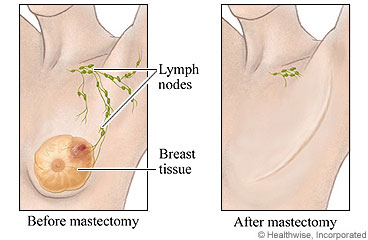
What is a mastectomy?
A mastectomy is surgery to remove the breast. It's often done as part of breast cancer treatment. It may also be done to prevent breast cancer. The type of mastectomy depends on the type and location of the cancer and your treatment plan. It also depends on whether you have breast reconstruction, and whether it's done at the same time as the mastectomy. Talk with your doctor about your surgery options and whether any lymph nodes will be removed.
What are the types of mastectomy?
- In a simple or total mastectomy, the entire breast is removed. The lymph nodes may be removed. This surgery is often done for people who have ductal carcinoma in situ (DCIS) or for people who have invasive breast cancer. This surgery is also used for people who are having a breast or both breasts removed to prevent breast cancer.
- In a modified radical mastectomy, the entire breast and the lymph nodes under the arm (axillary lymph nodes) are removed.
- In breast-conserving surgery (lumpectomy or partial mastectomy), the tumor and some healthy breast tissue are removed. Most of the breast remains. The doctor may remove only the cancer and a small part of the breast or up to about a quarter of the breast. The amount of breast tissue that is removed is different for each surgery.
- A skin-sparing mastectomy may be used for a simple or modified radical mastectomy. This removes the whole breast, the areola, and the nipple, but it keeps the skin that covers the breast. The breast tissue is removed through a cut that is made around the nipple. This technique does not harm the skin. Sometimes the nipple can be saved. This is called nipple-sparing mastectomy. Lymph nodes may be removed through the same cut made around the nipple or through another cut in the armpit.
- A radical mastectomy is very rarely done. In this surgery, the entire breast, all of the lymph nodes in the armpit, muscles under the chest, and some of the surrounding fatty tissue are removed. It is used only when a person has many tumors and when cancer has entered the chest.
The type of surgery you have depends on:
- The tumor size, type, and location.
- The size of your breast.
- The cancer stage.
- Whether or not the cancer has spread to the lymph nodes.
- Whether or not you've had radiation treatment.
- Whether you have breast reconstruction, and whether it's done at the same time as the mastectomy.
- Your age and health.
You and your doctor can decide which surgery is right for you.
If a person has a high risk of getting breast cancer, the breasts may be removed. This is called a prophylactic mastectomy. It can help prevent breast cancer.
What can you expect after surgery?
You will probably be able to go back to work or your normal routine in 3 to 6 weeks. This depends on the type of work you do and any further treatment. Talk with your doctor about other treatment you may need.
Lymph nodes
Lymph nodes are often removed from your armpit at the time of your surgery. Avoid heavy lifting and strenuous upper body activities until your doctor says they are okay.
Removing lymph nodes raises your risk of lymphedema. This is a condition in which fluid builds up and causes swelling. Try to protect your hand and arm from injury and infection. Infection can increase your risk of swelling. Your doctor or physical therapist may recommend exercises that will help you move your arm as you always have.
Appearance
Expect to have one or two tubes, called drains, to collect fluid from the surgery area. You will learn how to take care of them. They are usually removed in 1 to 2 weeks. How your chest looks after the surgery varies. Some people choose breast reconstruction. Reconstruction may be done during the same surgery as the mastectomy. Some people choose to use breast forms. Some people choose to have a flat chest. This may be called a flat closure. You will have a scar, but it will fade in time.
Follow-up care is a key part of your treatment and safety. Be sure to make and go to all appointments, and call your doctor if you are having problems. It's also a good idea to know your test results and keep a list of the medicines you take.
Where can you learn more?
Go to http://www.healthwise.net/patientEd
Enter L937 in the search box to learn more about "Learning About Mastectomy".
Current as of: October 25, 2024
Author: Ignite Healthwise, LLC Staff
Clinical Review Board
All Ignite Healthwise, LLC education is reviewed by a team that includes physicians, nurses, advanced practitioners, registered dieticians, and other healthcare professionals.

